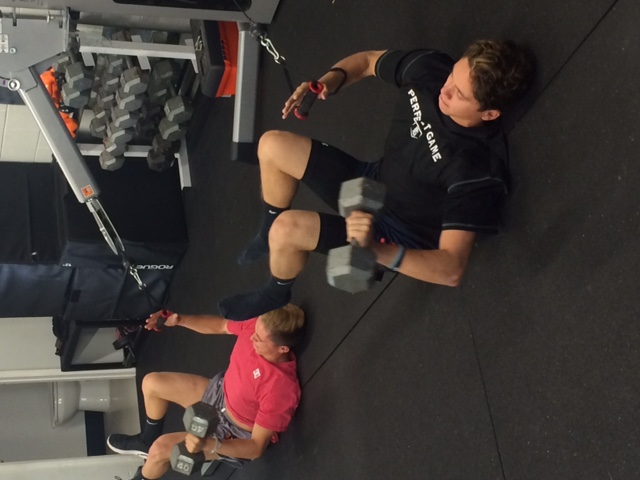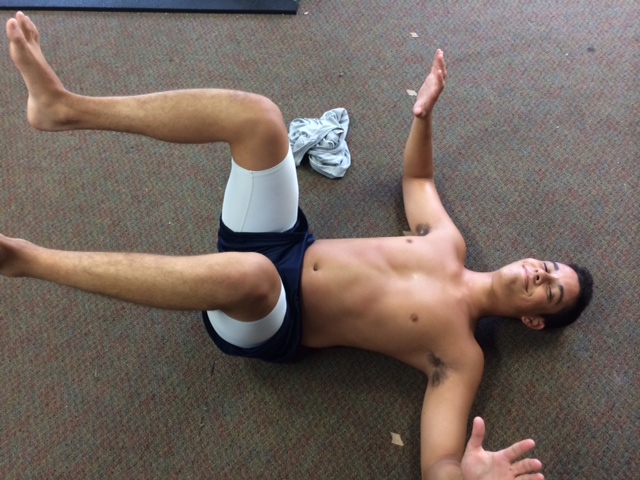Bench Pressing with your feet up has been frowned upon by most “elite” strength coaches through the nation. Reasons are often the lack of stabilization, lack of support, and the lack of drive into the ground which takes away from how much you can lift. Most importantly, coaches say it’s dangerous. All of these are true statments. And still, with all the bad press that benching with your feet up gets, I still bench that way and I attribute my personal successes on the bench to it. All of my athletes begin benching with their feet up as I progress them into a full bench press.

The average gym goer that benches with their feet up will say they do so because it trains their abs more. These people don’t quite understand how important what they’re doing really is, when done properly. There have been multiple times in my career where my knowledge as a strength coach was questioned and disrespected because of exactly this. By the end of the article you WILL have more respect for benching with your feet up, and if you are serious about getting your bench to a new level, you will begin experimenting with it yourself. (*NOT TO BE DONE ALONE UNLESS YOU HAVE GREAT SAGITAL STABILIZATION)
A strong bench press is 1.5-2x your body weight. Benching your body weight isn’t impressive, sorry. Getting your bench press to this higher level requires strong bench press technique that results in efficient loading and efficient transferring of force throughout your entire body. This is impossible without excellent sagittal stabilization.
Address Sagittal Stabilization
Sagittal stabilization, as described in previous articles, is literally stabilization of your body in the sagittal plane. Your body does this with elongation of your spine, supported by ideal intra abdominal pressure. Proper sagittal stabilization, in turn, allows for ideal joint positioning and ideal transferring of force and energy though your shoulders and pelvis. In terms of your bench, this efficient loading will allow you to transfer more force into the ground, resulting in a greater force into the bar. Not to mention less pain in your back, shoulders, elbows, and wrist. A strong bench press (2.0 x BW and higher) requires tremendous sagittal stabilization.
As humans, we develop this stabilization pattern at 3 months old on our way to walking. Dynamic Neuromuscular Stabilization (DNS) coins this as being the, you guessed it, 3 month position. What does three months look like? Well lying supine, shoulders and hips centrated, with elongation along the spine from head to butt. It’s not until a baby owns this position that they progress to side supporting, crawling, squatting, walking, etc.
Getting back to the bench press, as stated, a strong bench requires sagittal stabilization. Watch any average bench presser (BW bench press) and you will see horrendous overall stabilization. What does this look like? Well typically you see ribs flaring, shoulders elevating and shifted anteriorly, knees collapsing and moving from side to side, breathing all over the place between and during reps, and my favorite, feet scrambling, as the body tries to stabilize. Usually individuals who look like this will also say benching is bad for their shoulders or hurts their back (any exercise done improperly is bad for your shoulders, back, etc.).
Correcting this flaw in your bench is more than a single cue or single exercise away. It will take time, but the end goal will not only carry over to your bench, but nearly every other exercise.
Progressions
The following is a brief way that I correct poor sagittal stabilization, in relation to the bench press.
1. Re-eastablish Sagittal Stablization
Sagittal stablization before benching
An athlete that comes in with less than ideal stabilization (all but one of my athletes falls into this category) finds himself supine on the floor working on breathing and maintaining Intra abdominal pressure (IAP) before touching a single weight besides pinky. I will spend the first few times with an athlete working specifically on DNS neural developmental sequences specific to their less than ideal movement patterns that I pick up during the assessment. The improvements in movement coincide with the amount of time you spend working on it. The more the merrier! I equate the huge gains my athletes see on the field and once they really start lifting to just this. This stuff is magic!
straight arm straight leg raise 3 month
The video above is one of the important patterns I expect of every athlete as we progress into more complex movement. The key to this exercise is elongation through the spine, no lateral shifting through the shoulders and pelvis, good intra abdominal pressure, and ideally legs straight. A week prior to the video, Rusty struggled to complete the movement while even keeping his knees at 90 degrees...not bad for a week! We improved hamstring "flexibility" without any stretching!!! aka improved joint centration and connection between his pelvis and core musculature.
2. 3 Month Single Arm DB Press
3 month single arm db press <----good stabilization
When an athlete develops the ability to support efficiently on both sides during ipsilateral developmental patterns, we start taking steps towards a single arm dumbbell press in the 3 month position. To complete this exercise properly, an athlete must have an incredible amount of sagittal stabilization, which will prevent the pelvis from shifting from one side to the other. If they don't have this stability, their legs will shoot in the opposite direction trying to help support, they will shift through their shoulders and various other escapes.
For those who say there has to be four point of contact every time you bench, there is. You have both scapula that are loaded into the floor or bench, as well as your pelvis.
To assist in supporting through the pelvis, I’ll put bands around the knees, and cue the athlete to press their knees out. It’s incredible how increasing loading through the pelvis can positively effect positioning and stabilization at the shoulder and vice versa. It’s one of my favorite things to point out to my athletes and their parents! It often blows their mind.
banded single arm 3 month db press <----decent stbilization, obviously to heavy
Side note* This exercise is pointless if you allow yourself to escape into decentrated positions, ie. squirm, roll, and shift or extend through your spine. The point is to be in control and own the 3 month position. There should be no excessive movement at any other joint.
no band single arm 3 month db press <-----terrible stabilization
3. 10 Month Single Arm DB Shoulder Press
While improving the 3 month position, I will also begin to put my athletes into the 10 month position for single arm DB shoulder press. Again, this requires a large amount of sagittal stabilization that will prohibit shifting through their hips, kyphosis (rounding of the back), and joint centration through the shoulders. You will see this centration in the shoulders when both shoulders are level and pressed away from the ear while pressing overhead.
The 3 Month Barbell Bench press
After truly owning the three month position, we progress to the “dreaded” benching with the feet up. At my gym we call this, 3 month bench press. You should have complete confidence in your own or your athlete’s ability to stabilize and maintain joint centration at the spine, hips, and shoulders.
So how do you do it? Set up under the bar, brings those feet up so you have 90 degrees of knee and hip flexion, centrate your shoulders, set your intra abdominal pressure to stabilize your spine, and give it a whirl. The exercise is done properly when the bar travels in a straight path, your lower body remains stable, and there is no excessive shifting in your body. It should be relatively easy compared to the 3 month single arm dumbbell press and single arm shoulder press you have implementing into your training program.
The key to this exercise is how you set the pressure through your stomach. In this video, watch how the abdominal wall shifts down and away before the lift off. This pressure should be kept, or reset when it feels lost.
Benefits
1. A bigger bench without pain. It’s pretty simple, the better the joint centration during the movement, the more efficiently force is transferred through your body. I’m not in the business of making average athletes. I make kids great.
2. When I was still spending time working with military personnel, I often had my guys with back pain benching with their up. And guess what happened, not only were they able to do an exercise that they love and got stronger, but they were able to do it without pain and without falling off the bench!
Conclusion
Our world of strength and conditioning is continually evolving. In a sense, understanding movement is causes us to take a few steps back and cause us to re-establish "basic" movements and positions. Benching with your feet up is one way that I do this. My goal as a strength coach is to keep kids healthy and on the field, while making them monsters in the gym. In order for me to make this happen, my athletes all start in these "basic" positions. These "basic" positions, when done properly will make even the "strongest" athletes sweat and work like they haven't worked. I've been there, and now I am even stronger then where I was since implementing DNS Principles into every facet of my movement and training.
Have a strong day!
